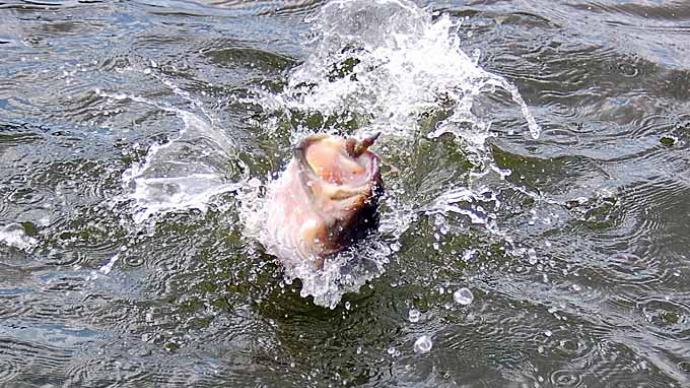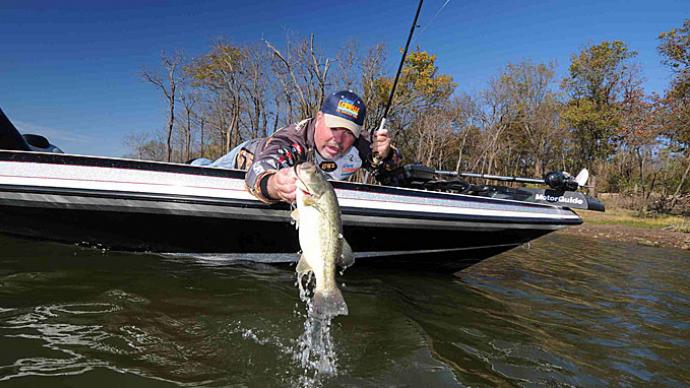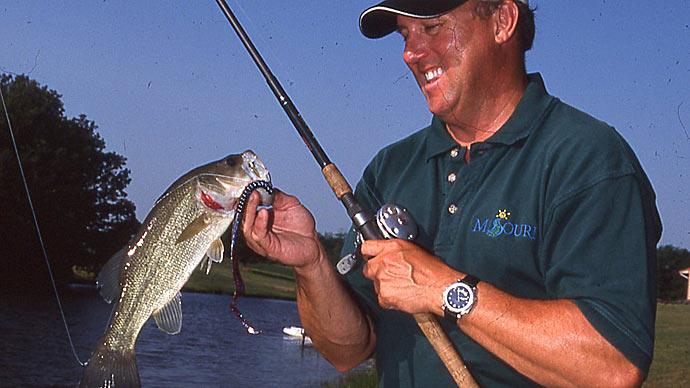| For more information: |
If you're after a trophy bass, the worm is probably the best lure you can use. Many Bass anglers regard plastic worms as the most effective lure for big bass. Their long, thin profile and lifelike action suggest a wide range of prey. Yet, despite their ability to catch bass, worms are often misused and misunderstood. They're a "feel" bait that requires some technique.
It takes many hours of trial and error to master the art of fishing with a plastic worm. Nevertheless, those good at it develop an uncanny sense of touch and timing and frequently pull in the biggest bass. As with most styles of fishing, however, practice is the key. The more familiar you are with the worm, the more fish you catch.
They're an eye contact bait meaning the fish must see it to hit it. Therefore they produce best in clear to stained water. Worms are most effective in warm water (above 55 degrees), especially during Summer. But don't be afraid to use them in the dead of winter - you may be pleasantly surprised.
Rigging Methods
There are many different ways to rig a worm. Here are the most popular:
Texas Rig

The most popular worm-fishing technique but also the most difficult to master. In this rig, the hook is threaded through the tip of the worm, and the point is turned back into the head of the worm to make it weedless, meaning the point is not exposed and will not get snagged in the weeds.
When fishing in heavy cover, you can peg the slip sinker by inserting a toothpick through the hole of the sinker. This will keep the sinker from hanging up and increase your feel of the lure. To prevent the worm from sliding down the hook shank, push the eye of the hook down into the plastic worm, spear a 50lb test piece of monofilament fishing line through both the tip of the worm and the hook eye, and trim the ends of the monofilament.
Floating Rig
This is a sight bait, meaning the fish must see it to strike it. Therefore it works best in clear water. Use this worm weightless, and cast it under overhanging trees and near flooded bushes in shallow water. Use a float/twitch/float retrieve. Attach a swivel about 8 inches ahead of the lure with heavier pound test line than what you're using. You may have to use a small hook on a buoyant worm to let the rig float. An offset shank hook works best.
The Carolina Rig

This works best on schooling smallmouths and as a search-type bait. The heavy sinker (usually 1 ounce) helps maintain bottom contact. As the sinker bounces along the bottom, the suspending worm placed as much as three feet from the sinker darts and settles like a baitfish. The length of the leader is determined by water clarity - in muddy water, use a shorter leader, and use a longer leader in clear water. The hookset isn't a snap-set. Instead, use a hard pull-set (sweep the rod to the side).
A 7 1/2-foot flipping stick works best. Use 14-17 pound test line and 10-pound test on the leader. Retrieve along ledges, sandbars, flats, long points, and other structures at medium speed. Use weedguards when fishing heavy weeds.
A popular variation is the Do-Nothing worm which has two small, exposed hooks built into it. Lizards, 'centipedes' and 'french fries' are other popular baits.
The Swimming Rig
Use a swivel and leader line. Attach a 6-inch straight worm rolled on the hook to make it semi-weedless. Using a slow, constant retrieve, fish around shallow boat docks, grassy shorelines, etc.
Choosing Styles and Colors
Color and style make a big difference, so always have a good assortment of colors, styles, and lengths and a good supply of different worm weights. An assortment of weenie worms, craw worms, lizards, curl tail, finesse, and ribbon-tail worms will cover nearly every situation.
- Bulkier worms with twist tails, multiple tails, appendages, or similar attention-getting devices usually are best in water of low visibility and thick cover. Still, they can also work in clear water because everybody throws small baits.
- Use thin worms with straight tails in vegetation.
- When fish are inactive, try using a smaller worm.
- In clear water, lighter, more translucent colors tend to work best: blue, green, pearl, smoke, etc.
- In dark water, dark worms often produce the best: purple, black, brown, etc.
- Two-toned worms are better when the less dominant color is highly attractive, such as bright yellow or red, and the dominant color is more conservative, such as black or blue. Therefore, metal flake colors are often the key to fishing success.
-
In choosing worm colors, stick to a color that works in your area, but don't be afraid to experiment. Worms are among the least expensive bass lures you'll buy. Most professionals use shades of purple. Fluorescent colors retain their color in deep waters, whereas other colors turn grey. Color can be something to consider after you find the bass. If they're following the lure, tapping it, or just not hitting it and you tried different presentations, try a different color of the same lure.
Generally, use dark colors in water with little light penetration, such as muddy or stained water and cloudy or windy days. And use light colors in water with more light penetration - i.e., clear water, sunny or calm days, etc.
Use natural colors. Big bass learn from being caught not to resort to their curiosity to react to everything unnatural. That's why natural-looking baits produce bigger bass.
Weights
Use the lightest slip sinker you can. The lighter the weight, the more natural action the worm will have. In most situations, a 1/16 to 1/8 ounce sinker will be heavy enough in water less than 6 feet deep; a 1/8 to 1/4 ounce sinker for 6 to 12 feet; a 1/4 to 3/8 once sinker for 13 to 18 feet and a 3/8 to 1/2 ounce sinker for water deeper than 18 feet. Needle nose weights are good for vegetation but hang up in rocks and gravel. Use bullet weights instead.
Fishing Techniques
When fishing the Texas rig, use a medium to heavy action rod with a fast tip for better hooksets and more sensitivity. Use 7 to 7 1/2-foot rods - they don't over-move the worm as longer ones do. Use 8 to 14-pound test line.
Follow this procedure:
- Cast the worm past the cover or a drop-off.
- Let the worm fall to the bottom on a slack line, then engage the reel. Watch the line for any movement that may indicate a strike. Don't twitch and shake it as it falls. It gives the bass too much time to analyze the worm. Instead, let it fall on his face now - you'll get a reaction strike.
- When the worm hits bottom, raise the rod tip slightly, then let it fall. Repeat. Remember to keep the rod high (at about the 10 o'clock position) and face the worm during the retrieve. Be a line watcher. Stay alert for any twitch or side movement of the line. Check for a bass at the end of your line before moving the worm by pulling lightly. If he's tapping it, jiggle it a little, let it rest, and check again. Try different techniques to get him to pick it up.
- When a strike occurs (you'll feel a tap on your line or detect movement in the line), immediately lower the rod tip and bring the rod back overhead sharply. This slack-line hookset will drive the hook point into the bass' tough jaw. Never allow a bass to swim with the worm. On the strike, set the hook as quickly as possible. Always set the hook with a solid upward jerk. However, you don't need to tear the boat seat out of the boat on the hookset. If you're rigged right, the bass will practically hook itself.
- If you miss, drop the lure back down to the bottom now! (Don't reel up and re-cast) Many times the bass will come back and hit it again.
- Reel quickly to move the bass away from heavy cover, then slow down and play the fish.
Tips
- Match the size of the hook to the size of the worm. For example, a 3/0 to 4/0 hook is ideal for most 7-8 inch worms. A 1/0 is too small, and a 6/0 is too large. A 2/0 hook is best for 5-6 inch worms, and 1 and 1/0 for finesse worms.
- Be extremely conscious of hook sharpness.
- Pull set (tighten up and then pull - not snap) anytime the strike is close to you (when flipping and pitching, for example).
- When in doubt, always set the hook - swings are free.
- Worm fishing requires lots of concentration.
- Store worms in "worm-proof" tackleboxes or plastic bags where they cannot touch other lures. Otherwise, chemical reactions will harm both lures.
- Use scents and salt-impregnated plastics - worms packaged in salt aren't worth the money because the salt washes off on the first cast.
- During the heat of the summer, try tying on a U-tale worm from Zoom. These work great. My favorite colors are chartreuse pepper and motor oil w/chartreuse tail. I caught one 6-pounder, two 5-pounders, and two 4-pounders (not to mention about 40 small ones) in one day with these two colors. Good Luck!
- Use a large purple and pink worm with a beetle spin. The bright color of the worm and the shiny spinner attracts the fish that are 10-15 feet out.
- The best worm ever to use is a Zoom Trickworm. Especially Watermelonseed Color. Texas rig it in clear lakes, and you will catch plenty of keeper bass. -- Jonathan, Central Florida Pond Prowler
- In the summertime, use a tequila colored 7 inch worm in 6-15 feet of water. The bass can't resist it. Slowly lift and jiggle the worm across the bottom. You can cast the worm under high docks (1-2 feet above the water) and snag a few good-sized shade seekers. Good luck!
- When fishing in a murky farm pond, try using a green 2-inch worm. Reel it in quickly, then let it fall. Do this over again until it is back to you. Try varying the speed of how fast you are reeling in. This works very well on sunfish and some smallmouth bass.
- I like to use black or purple worms here in Ohio or go to the Rooster Tail.
- Try placing a 6-inch plastic worm inside the hollow part of a large tube. It works best if the tube and worm are the same colors. The fringes on the tube seem to entice the bass. Fish the worm with a Texas rig. I caught a 6-pound bass using this method.
- I've grown up in Florida fishing canals and small lakes and found that a "cheap" Wal-Mart brand worm is the most effective bait. The Renegade brand "pink twirl-tail." Just put it on the hook and cast it. Let it drop, and then do the usual retrieval process.
- From early May until the end of September, I always throw a 7 1/4-inch blue flip-tail worm and an 8-inch blue Jelly Worm. The blue worm works around brush and stumps when the sky is relatively straightforward on a hot, humid day.
- Today's craze is putting a rattle on every jig and worm you throw. Do minnows rattle as they swim through the water? Do worms and snakes rattle as they slide across the bottom? I have found that this sound is very unnatural. Keep it simple and throw a standard Texas rig with no rattle!
- When rigging any soft plastic on a Texas rig, put a toothpick in the bottom of the bullet weight, slide in, and break off the pick. This is called "picking," which stops your weight from sliding up your line. Good, especially for flipping around the cover.
- Suppose you're at a dark and shady lake using very bright colors. However, if you get a worm that is the same shade as the water except for the tail part, you will get perfect hits.
- When fishing with plastic worms, I like to find a nice murky warm spot with an excellent cover of weeds on the surface. I use a weightless Texas rig, skim the worm across the surface, and slowly retrieve it. Then, I pause it, letting the worm slowly fall off the cover. I usually get nailed when my worm reaches about a foot under the surface.
- If you like fishing plastic worms, you know that if the fish are biting, you can easily go through a whole bag of worms in a few short hours. Most of the time, if you don't lose the worm, the head will be all ripped up from catching all those fish. To save a lot of money on jig and spinnerbait trailers, pinch off the bad part of the worm and use the rest as trailers!!! The color combinations are endless, and you have many different sizes and style options.
- Most professional anglers don't aim right on a floating log or bass hideouts when casting. Instead, they usually cast the bait a foot or so near it. Also, use a hidden weight hook when casting near those areas.
- I like to use motor oil color. So I out-fished my friend on clear water and a hot day at 11:1 with the forgotten motor oil worm. We had used everything we had, then I pulled out the motor oil and had one of the best days I have ever had.
- When fishing in the morning, use a lighter-colored worm. Also, make a continuous slight jerking motion to cover more ground, but make sure the motion is not too big.




